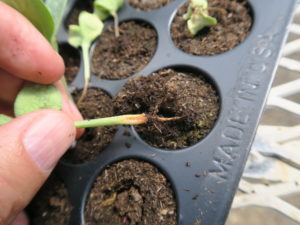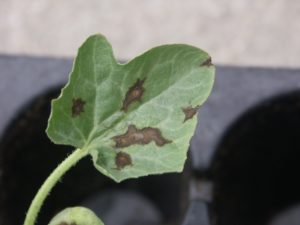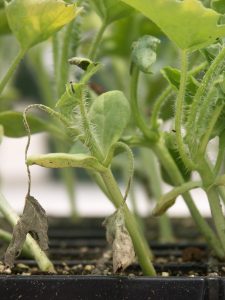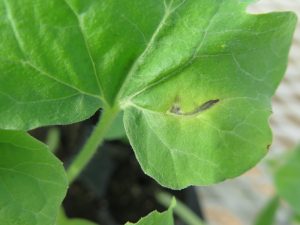Many cantaloupe and watermelon growers are either growing transplants in a greenhouse or are expecting delivery of transplants in the next few weeks. Either way, growers should inspect transplants for disease before planting in the field. Below I will describe several common transplant diseases of cantaloupe and watermelon as well as management options.
Gummy stem blight on transplant seedlings may be recognized by the watersoaked area of the stem near the seed leaves (Figure 1). The watersoaked area may eventually turn brown and woody. A closer look at the woody area may reveal the small, dark fungal structures of the gummy stem blight fungus. Medium brown, irregular lesions may also be observed on true leaves. A watersoaked area near the soil line is more likely to be damping-off (Figure 2).
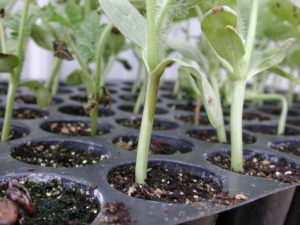
Figure 1. A common symptom of gummy stem blight of watermelon is a watersoaked area where the seed leaves attach to the stem.
.
The fungus that causes gummy stem blight (Stagonosporopsis spp.) may survive in crop debris, thus overwintering in the field from year to year. This fungus may also be introduced through seed or transplants. It is also possible for the fungus to survive in greenhouse production facilities.
Anthracnose of watermelon is another disease that may be observed on transplants. The lesions caused by anthracnose (Colletotrichum orbiculare) are often jagged or sharp in appearance (Figure 3). Stem lesions are less common, but if they occur they may appear watersoaked, light brown and pitted. Such stem lesions will not necessarily appear at the seed leaves. Anthracnose on cantaloupe transplants is less common.
As described above for gummy stem blight, the fungus that causes anthracnose may survive in crop debris such as in transplant production facilities. This fungus may also be introduced through seed or transplants.
Watermelon transplants with Fusarium wilt often appear wilted or the plant tops may have died back (Figure 4). Symptoms that appear under humid greenhouse conditions may be accompanied by white mycelial growth of the causal fungus, Fusarium oxysporum f.sp. niveum. Seedlings with Fusarium wilt symptoms may be clustered in transplant trays.
Fusarium wilt may be introduced through seed or transplants. Unfortunately, the fungus that causes Fusarium wilt has long-lived spores that may survive for years in soil, equipment, or transplant trays.
The symptoms of bacterial fruit blotch (BFB) can be difficult to recognize on foliage. Leaf lesions may have a dark necrosis with watersoaked margins (Figure5). Leaf symptoms of BFB are easily confused with angular leaf spot, a disease that is not often economically important. A laboratory analysis may be required to distinguish these two diseases.
The bacteria that cause BFB do not often survive in crop debris; the disease is more often transmitted through seed. Although symptoms are more often observed on watermelon, cantaloupe transplants may also be affected.
To guard against these diseases in your field, carefully inspect transplants regularly during production or upon delivery. If unsure about symptoms, send them to the Plant Pest and Diagnostic Laboratory or a similar laboratory for an official diagnosis. Clean and sanitize transplant production facilities and equipment in-between generations. Purchase transplant trays for each generation of transplants or clean and sanitize trays well. Do not use soilless greenhouse mix that has been opened or come into contact with the ground or unclean equipment.
Purchase vegetable seed that has been tested for the diseases described above. Ask your seed company representative if you are uncertain about what tests have been conducted.
If fungicides are applied during transplant production, growers should choose a product that is allowed for greenhouse use. In addition, a contact fungicide with the FRAC group M is recommended so that future use of systemic products will be easier to schedule. Fungicides with the active ingredient mancozeb (e.g., Dithane®, Manzate®, Roper®, Penncozeb®) should serve most purposes.
Finally, avoid planting transplants grown from seed lots or greenhouses where any of these diseases has been confirmed. Seedlings that appear healthy may in fact have a disease that has spread from a nearby seedling.
In most years, it will be impossible to avoid at least some of the diseases described above. But, as much as possible, do not plant these diseases with your transplants. In particular, avoid using transplants with Fusarium wilt. Since the Fusarium wilt fungus survives many years in the absence of a host, an introduced fungus may last indefinitely. Plus, watermelon transplants with Fusarium wilt may add a new race or strain of the fungus to your field.
Managing these diseases in the field is a different discussion and will be addressed in many articles throughout the year.
This article was updated from an article published in May 6, 2020 in issue 673.
